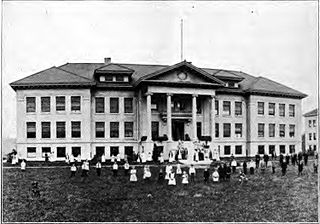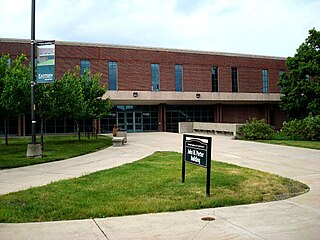
Gallaudet University is a private federally chartered university in Washington, D.C., for the education of the deaf and hard of hearing. It was founded in 1864 as a grammar school for both deaf and blind children. It was the first school for the advanced education of the deaf and hard of hearing in the world and remains the only higher education institution in which all programs and services are specifically designed to accommodate deaf and hard of hearing students. Hearing students are admitted to the graduate school and a small number are also admitted as undergraduates each year. The university was named after Thomas Hopkins Gallaudet, a notable figure in the advancement of deaf education.

Indiana State University (ISU) is a public university in Terre Haute, Indiana. It was founded in 1865 and offers over 100 undergraduate majors and more than 75 graduate and professional programs. Indiana State is classified among "D/PU: Doctoral/Professional Universities".
The Louisiana School for the Deaf is a state school for deaf and hard-of-hearing students in Louisiana, located in Baton Rouge, the state capital. It was established in 1852 as a joint school for blind students. In 1860, its first purpose-built facility was completed and admired as an elegant monument to philanthropy. The schools were divided in 1898, and in 1908, Louisiana School for the Deaf was renamed.

The Florida School for the Deaf and the Blind (FSDB) is a state-supported boarding school for deaf and blind children established in 1885, in St. Augustine, Florida, United States.

Mainstreaming, in the context of education, is the practice of placing students with special education needs in a general education classroom during specific time periods based on their skills. This means students who are a part of the special education classroom will join the regular education classroom at certain times which are fitting for the special education student. These students may attend art or physical education in the regular education classrooms. Sometimes these students will attend math and science in a separate classroom, but attend English in a general education classroom. Schools that practice mainstreaming believe that students with special needs who cannot function in a general education classroom to a certain extent belong in the special education environment.

Indiana School for the Deaf (ISD) is a fully accredited school for the deaf and hard of hearing, located in Indianapolis, Indiana.

The Kentucky School for the Deaf (KSD), located in Danville, Kentucky, United States, is a school that provides education to deaf and hard-of-hearing children from elementary through high school levels. Founded in 1823, it was the first school for the deaf west of the Allegheny Mountains. Jacobs Hall, its oldest surviving building, was designated a National Historic Landmark in recognition of this history.

The Ohio School for the Deaf is a school located in Columbus, Ohio. It is run by the Ohio Department of Education for deaf and hard-of-hearing students across Ohio. It was established on October 16, 1829, making it the fifth oldest residential school in the country. OSD is the only publicly funded residential school for the deaf in Ohio.

Oregon School for the Deaf (OSD) is a state-funded school in Salem, Oregon, United States. It serves deaf and hard of hearing students from kindergarten through high school, and up to 18 years of age.

Leigh High School is a secondary school located in the West San Jose region of San Jose, California, United States. Opening in September 1962, it was the fifth school established in the Campbell Union High School District. The school has twice been given the California Distinguished School award, in 1999 and 2003. As of 2020, the school's enrollment was 1809 students. The school colors are gold (yellow) and pine green, and its mascot is the Longhorn.
The Wyoming School for the Deaf was a school for deaf elementary students located in Casper, Wyoming, United States. The school was open from 1961 until it was closed due to a lack of students in 2000. The school was created to accommodate the concerns of parents who did not want to send their deaf children to schools in other states. Early pilot programs were conducted, and in 1959, a house was purchased across from the local Pineview Elementary School and used to house the program. In 1961, the state legislature appropriated more funds for the program and a permanent school was built and dedicated in 1963.
The Vermont Center for the Deaf and Hard of Hearing, a non-profit organization, was the primary educational and support services resource for Deaf and Hard of Hearing residents in Vermont and surrounding areas. The Vermont Center, headquartered at Brattleboro’s Austin’s School For The Deaf, was launched by the Austine School in 1998 and operated until 2014. The Austine School was one of four independent schools and twelve outreach programs through which the Vermont Center assisted thousands of Vermonters who had hearing loss.
Delaware School for the Deaf (DSD) is a public K–12 school located on East Chestnut Hill Road in Brookside, Delaware, United States; It has a Newark postal address. The Christina School District operates the school, but because it is state-funded, the budget is separate from the rest of the district DSD operates Delaware Statewide Programs for the Deaf, Hard of Hearing, and Deaf-Blind.

The Eastern Michigan University Department of Special Education is among the oldest special education programs in the United States. The Department of Special Education falls under the Eastern Michigan University College of Education at Eastern Michigan University in Ypsilanti, Michigan. The Eastern Michigan University Department of Special Education provides extensive studies for those wanting to participate in the disabled community. There are currently five programs or courses of study one may choose to follow, if they wish to obtain a bachelor's degree and a recommendation to the Michigan Department of Education K–12 endorsement as a teacher of students with impairments.
The Described and Captioned Media Program (DCMP), originally known as Captioned Films for the Deaf, Inc. in 1950, and later known as Captioned Films and Videos and the Captioned Media Program, is a national nonprofit funded by the United States Department of Education under federal Public Law 85-905. It is currently administered by the National Association of the Deaf.
The Scranton School for Deaf and Hard of Hearing Children is a specialized private school located in Clarks Summit, Pennsylvania serving deaf and hard of hearing students from Northeast and Central Pennsylvania, United States. Formerly administered by the Pennsylvania Department of Education, the Scranton State School for the Deaf was closed at the end of the 2008–2009 school year. All rights to administer the school were transferred to the Western Pennsylvania School for the Deaf.
Iowa School for the Deaf is a pre-K to 12th grade school for deaf and hard-of-hearing students located in Council Bluffs, Iowa. It serves students who live in Iowa and Nebraska.
The National Center on Deafness is an American educational institution aimed at facilitating the education of deaf students. The facilities of the National Center on Deafness are located on the campus of California State University, Northridge, Los Angeles, California. Each year the university hosts the International Conference on Technology and Persons with Disabilities.
Kendall Demonstration Elementary School (KDES) is a private day school serving deaf and hard of hearing students from birth through grade 8 on the campus of Gallaudet University in the Trinidad neighborhood of Washington, D.C. Alongside Model Secondary School for the Deaf, it is a federally funded, tuition-free demonstration school administered by the Laurent Clerc National Deaf Education Center at Gallaudet University.
South Korea's Deaf population began to come to prominence in recorded history in the late 19th century with the implementation of special education. Since then, they have gained government recognition and legal rights.












